AMD Radeon HD 7970 3GB Graphics Card Review

With its new Tahiti GPU architecture, highest-ever clock rates and 384-bit memory bus, how fast is the new single-processor flagship graphics card from AMD? Find out from our review!
At the very end of the last year AMD introduced its new GPU codenamed Tahiti and one graphics card based on it. The card is called Radeon HD 7970 and supposed to be followed (presumably in February) by a less advanced and more affordable Radeon HD 7950.
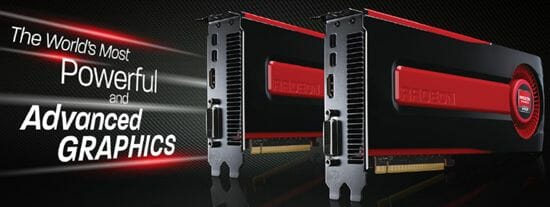
Announced on the 22nd of December, the Radeon HD 7970 went on sale on the 9th of January only. And it is yet rather hard to find in shops. There are can be numerous reasons for that, from imperfections in the new 28nm tech process to transportation problems due to natural disasters. So we’ll put the availability issue aside for now, but will instead focus on the new Tahiti architecture and the first graphics card based on it.
GPU Architecture
The Tahiti processor belongs with the Southern Islands family which is comprised of three GPU models:
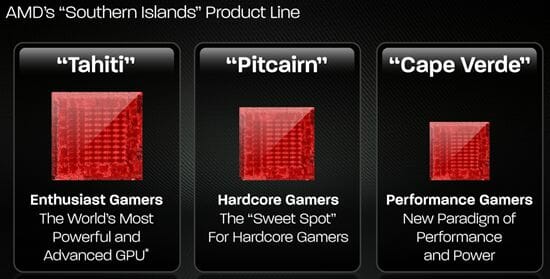
The Tahiti will be the heart of AMD’s fastest and most expensive high-end cards: Radeon HD 7970 and HD 7950. The Pitcairn will go to mainstream solutions, the most popular choice among gamers. Named Radeon HD 7870 and HD 7850, these cards are expected to come about in February. And, finally, the name of Cape Verde is reserved for the low-end Radeon HD 77xx series which is supposed to replace the Radeon HD 67xx series.
AMD refers to the architecture of its new GPUs as Graphics Core Next (GCN):
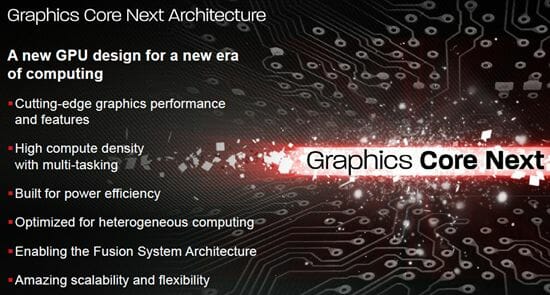
Besides the expectedly increased graphics performance, the GCN architecture is optimized for computing tasks, so the Southern Islands chips feature Compute Units.
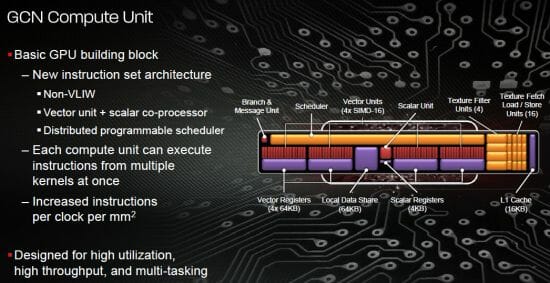
A non-VLIW Compute Unit combines vector and scalar subunits. Each GCN unit has a dedicated scheduler and can execute instructions from different programs. This multitasking orientation is a key feature of the GCN architecture at large.
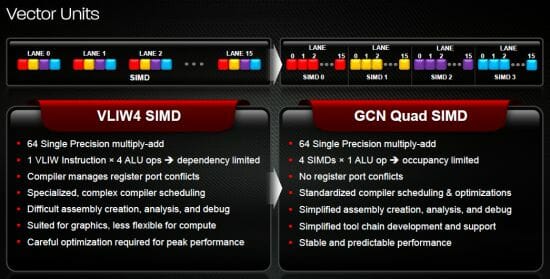
The new cache memory subsystem includes 16 kilobytes of L1 cache per each compute unit and 32 kilobytes for storing instructions. The L2 cache is 768 KB large. This is 50% larger than in the Cayman processor (Radeon HD 6970/HD 6950).
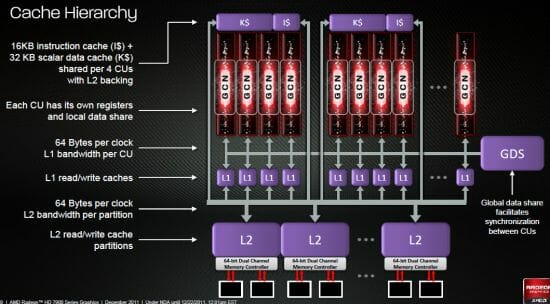
The cache memory has become 50% faster: 2 terabytes/s and 700 gigabytes/s for the L1 and L2 cache, respectively.
he Tahiti incorporates an enormous 4.3 billion transistors (compare this to the Cayman’s 2.64 billion). It now has a total of 2048 unified shader processors. The GPU also has 32 raster operators and 128 texture-mapping units.
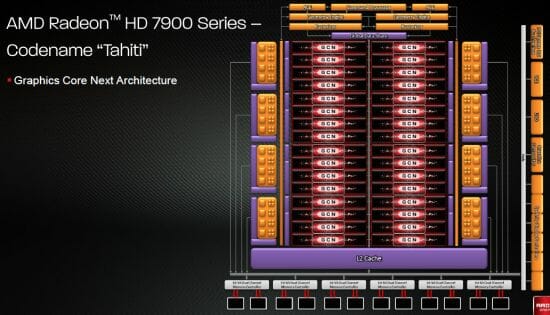
The GPU clock rate has grown up to 925 MHz. Combined with the rest of architectural improvements, it ensures a peak fillrate of 118.4 gigatexel/s. Thanks to the new 384-bit memory bus and high memory clock rate of 5500 MHz, the memory bandwidth is as high as 264 GB/s.
The ninth-generation tessellators are supposed to bring about considerable performance benefits, too.
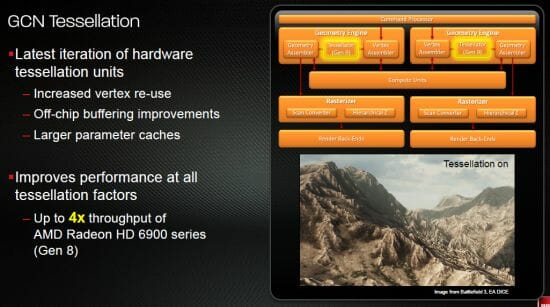
AMD claims the tessellation performance is now 4 times that of the previous GPU generation but the diagram suggests that this is not true for all tessellation-using applications.
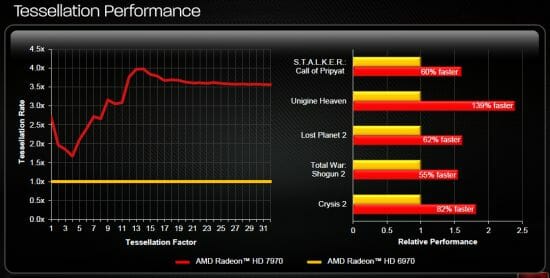
The quality of anisotropic filtering has also been improved.
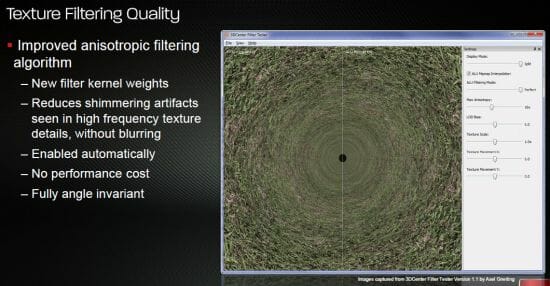
Moreover, the anisotropic filtering improvements are not supposed to cause a performance hit on the new AMD Radeon HD 79xx series as well as other cards based on the Southern Islands family processors. The new GPU brings about a lot of architectural innovations, so we’ve only covered the key points. Let’s just move on to the more exciting things. We mean the new graphics card and its speed in benchmarks.
Specifications
The AMD Radeon HD 7970 specifications are listed in the following table in comparison with the AMD Radeon HD 6970.
PCB Design
We’ve got a reference sample of the new AMD card without any packaging or accessories. Compared to the HD 6970, the HD 7970 looks more attractive with its glossy black cooler casing with a red insert and pressed-out letters “Radeon”.
This casing isn’t very practical as you can’t help leaving greasy fingerprints on it, but it does look splendid. The size hasn’t changed much since the previous flagship. The Radeon HD 7970 3GB measures 278 x 100 x 38 millimeters.
The new card has been deprived of one DVI output, but its vent grid has expanded thanks to that.
So, the connectors include one dual-link DVI-I, one HDMI version 1.4a, and two DisplayPorts version 1.2. Off-the-shelf versions of the card will come with an HDMI->DVI adaptor for connecting two monitors with DVI inputs simultaneously. Coupled with a special MST hub (to be released by summer 2012), the two DisplayPorts will enable Multi-Stream technology to support up to six monitors concurrently.
There’s nothing new about power connectors, MIO interface and dual BIOS. The Radeon HD 7970 features one 8-pin and one 6-pin power connector, two connectors for building CrossFireX configurations, and a small switch for choosing the BIOS to use.
Notwithstanding the 28nm tech process, the new card has not become more economical than its predecessor. The peak power draw is declared to be 250 watts in 3D applications. However, the Radeon HD 7970 is able to lower its 2D power draw down to 3 watts (when the monitor is turned off), something that the Radeon HD 6970 couldn’t do. If you’ve got a CrossFireX configuration, all graphics cards, save for the primary one, can be turned off upon leaving 3D mode, which should have a positive effect on the power consumption, noise and temperature of such rigs. We will surely check this out in our upcoming reviews of off-the-shelf Radeon HD 7970s.
The PCB and component layout do not seem to have changed much since the previous flagship.
But we can note a few differences. First of all, the reference Radeon HD 7970 features 5+1 power circuit design with 6 phases for the GPU and 1 phase for the graphics memory. The power system is managed by a CHiL CHL8228G controller.
High-quality DirectFETs can be spotted on the PCB. We’ve seen them before on MSI’s graphics cards. They are superior to the Radeon HD 6970’s Volterra components in electrical resistance, inductance and heat dissipation. These chips can give their heat away both to the heatsink and to the PCB.
The GPU has a metallic frame that protects not only the corners and edges of its wafer but also the area immediately around the die.
The die is positioned at 45 degrees and lacks any marking. The latter can be read from the frame. We’ve discussed the GPU configuration in the previous section. Here’s the info in brief: 2048 unified shader processors, 32 raster operators, and 128 texture-mapping units. The clock rate is 925 MHz at 1.17 volts in 3D mode and 300 MHz at 0.95 volts in 2D mode.
The card’s 3 gigabytes of GDDR5 memory are represented by 12 FCFBGA chips located on the face side of the PCB. Labeled H5GQ2H24MFR R0C, the chips are manufactured by Hynix Semiconductor.
They have a clock rate of 5500 MHz, just like on the Radeon HD 6970, but the memory bus is expanded from 256 to 384 bits, increasing the memory bandwidth from 176 to 264 GB/s. The memory clock rate is lowered to 600 MHz in 2D applications.
Cooling System and Noise
The AMD Radeon HD 7970 features a sixth-generation cooling system with a copper vapor chamber in its base and an improved fan.The cooler doesn’t look much different from its predecessor except that its base plate has become more intricately shaped.
But after removing the plastic casing, we can see that the aluminum heatsink has become larger than in the Radeon HD 6970’s cooler and now takes all the space between the card’s mounting bracket and fan.
The heatsink still consists of slim aluminum fins that are soldered to a copper vapor chamber whose sole has contact with the GPU die via gray-colored thermal grease. The memory chips and power circuit components contact the cooler via thermal pads of two types.
The blower has changed, too. Its blades have become slimmer and longer in order to pump more air through the heatsink.
Judging by the sticker, the fan is manufactured by NTK Ltd in China. Its part number is FD7525U12D, it runs on a dual ball bearing and its peak power draw is 20.4 watts. That’s all the information we can get from the fan’s own label. According to monitoring tools, its speed varies from 1030 to 5270 RPM.
We checked out the card’s temperature while running Aliens vs. Predator (2010) in five cycles at the highest settings (2560×1600, with 16x anisotropic filtering, 4x full-screen antialiasing).
We used MSI Afterburner 2.2.0 Beta 9 (and also Beta 10) and GPU-Z 0.5.7 as monitoring tools. This test was carried out with a closed system case at an ambient temperature of 25°C. We didn’t replace the card’s default thermal interface material.
Let’s see how efficient the cooler is in the automatic speed regulation mode and at the maximum fan speed.
In the automatic regulation mode the GPU temperature is as high as 85°C while the fan speed grows from 1030 to 2650 RPM. At the maximum speed of the fan (5270 RPM), the GPU is no hotter than 62°C. So, we don’t see much difference from the previous generation of AMD’s graphics cards in this respect. Perhaps the new cooler is quieter?
We measured the level of noise using an electronic noise-level meter CENTER-321 in a closed room about 20 sq. meters large. The noise-level meter was set on a tripod at a distance of 15 centimeters from the graphics card which was installed on an open testbed. The mainboard with the graphics card was placed at an edge of a desk on a foam-rubber tray.
The bottom limit of my noise-level meter is 29.8 dBA whereas the subjectively comfortable (not low, but comfortable) level of noise when measured from that distance is about 36 dBA. The speed of the graphics card’s fans was being adjusted by means of a controller that changed the supply voltage in steps of 0.5 V.
Besides the reference Radeon HD 6970, we’ve included the results of the MSI N580GTX Lightning Xtreme Edition and Sapphire Radeon HD 6970 Dual Fan into the following diagram. These cards have highly efficient original coolers. There will surely be Radeon HD 7970s with original coolers, too, but the reference version of the new card is far from quiet.
Although the Radeon HD 7970’s cooler is somewhat different, it is just as noisy as the Radeon HD 6970’s except that the new card is indeed quiet (and quieter than the HD 6970) in 2D mode. The fan accelerates at any 3D load, and you can forget about silence then. Well, we could have predicted this after examining the cooler as it hasn’t changed significantly since its predecessor. So, years go by but reference coolers do not change. If you want silence, you have to look for alternatives (for example, consider the Artic Cooling Xtreme 7970).
Overclockability
It’s already no secret that the 28nm AMD Tahiti chip boasts high overclocking potential and so does the Tahiti-based Radeon HD 7970. In fact, AMD put an emphasis on this fact in the presentation.
Many graphics card makers have already announced pre-overclocked Radeon HD 7970s and their factory overclocking is as high as 125 to 150 MHz or even more!
As for our sample of the reference card, we used MSI Afterburner 2.2.0 Beta 10 to overclock its GPU from 925 to 1130 MHz (+22.2%) and its memory from 5500 to 7000 MHz (+27.3%).
The memory bandwidth reached an enormous 336 GB/s and the texture fillrate notched 144.6 GTexel/s! The overclocked card grew 5°C hotter in terms of its GPU temperature and its fan accelerated to 2990 RPM.
Of course, you’ll need at least more efficient air cooling (and we’ll tell you about it in an upcoming review) or, better yet, a liquid cooling system for even better overclocking.
Power Consumption
We measured the power consumption of computer systems with different graphics cards using a multifunctional panel Zalman ZM-MFC3 which can report how much power a computer (the monitor not included) draws from a wall socket. There were two test modes: 2D (editing documents in Microsoft Word and web surfing) and 3D. We ran the benchmark from Metro 2033: The Last Refuge at 2560×1600 with maximum settings as the 3D load because this game could load both the graphics card and CPU. If we ran FurMark, for example, the system’s overall power consumption was 20-25 watts lower than with Metro 2033: The Last Refuge.
As you can see, the benefits of the thinner 28nm tech process are negated by the new card’s high clock rates, fast GPU architecture and 384-bit memory bus. The Radeon HD 7970 system needs as much power as the Radeon HD 6970 one. So, AMD was right in writing the same power draw number into the newer card’s specs. We, on our part, should be pleased as we’ve got higher performance but the same power draw as with the older product.
Testbed Configuration and Testing Methodology
Starting today we are going to upgrade our testbed with a new Intel X79 Express based mainboard, a powerful LGA 2011 processor, fast system memory and a new SSD drive. As a result our testbed features the following configuration:
- Mainboard: Intel Siler DX79SI (Intel X79 Express, LGA 2011, BIOS 0380 from 11/28/2011);
- CPU: Intel Core i7-3960X Extreme Edition, 3.3 GHz, 1.2 V, 6 x 256 KB L2, 15 MB L3 (Sandy Bridge-E, C1, 32 nm);
- CPU cooler: Noctua NH-D14 SE2011;
- Thermal interface: ARCTIC MX-4;
- System memory: DDR3 4 x 4GB Mushkin Redline (Spec: 2133 MHz / 9-11-10-28 / 1.65 V);
- Graphics cards:
- MSI N580GTX Lightning Xtreme Edition 3 GB/384 bit GDDR5, 772/1544/4008 MHz and 910/1820/4780 MHz;
- AMD Radeon HD 7970 3 GB/384 bit GDDR5, 925/5500 MHz and 1130/7000 MHz;
- Sapphire Radeon HD 6970 Dual Fan 2 GB/256 bit GDDR5, 880/5500 MHz;
- System drive: Crucial m4 256 GB SSD (SATA-III,CT256M4SSD2, BIOS v0009);
- Drive for programs and games: Western Digital VelociRaptor (300GB, SATA-II, 10000 RPM, 16MB cache, NCQ) inside Scythe Quiet Drive 3.5” HDD silencer and cooler;
- Backup drive: Samsung Ecogreen F4 HD204UI (SATA-II, 2 TB, 5400 RPM, 32 MB, NCQ);
- System case: Antec Twelve Hundred (front panel: three Noiseblocker NB-Multiframe S-Series MF12-S2 fans at 1020 RPM; back panel: two Noiseblocker NB-BlackSilentPRO PL-1 fans at 1020 RPM; top panel: standard 200 mm fan at 400 RPM);
- Control and monitoring panel: Zalman ZM-MFC3;
- Power supply: Xigmatek “No Rules Power” NRP-HC1501 1500 W (with a default 140 mm fan);
- Monitor: 30” Samsung 305T Plus.
Besides the new AMD Radeon HD 7970 graphics card, we also included MSI N580GTX Lightning Xtreme Edition and Sapphire Radeon HD 6970 DualFan.
Sapphire Radeon HD 6970 DualFan was tested at its default clock frequencies, and MSI N580GTX Lightning Xtreme Edition was tested at the nominal GeForce GTX 580 frequency of 772/1544/4008 MHz as well as at overclocked frequencies of 910/1820/4780 MHz (the maximum frequencies for this particular graphics card sample).
In order to lower the dependence of the graphics cards performance on the overall platform speed, I overclocked our 32 nm six-core CPU with the multiplier set at 45x and “Load-Line Calibration” enabled to 4.5 GHz. The processor Vcore was increased to 1.385 V in the mainboard BIOS.
Hyper-Threading technology was enabled. 16 GB of system DDR3 memory worked at 2.133 GHz frequency with 9-11-10-28 timings and 1.65V voltage.
The test session started on January 4, 2012. All tests were performed in Microsoft Windows 7 Ultimate x64 SP1 with all critical updates as of that date and the following drivers.
- Intel Chipset Drivers 9.3.0.1019 WHQL from 12/22/2011 for the mainboard chipset;
- DirectX End-User Runtimes libraries from November 30, 2010;
- Nvidia GeForce 290.53 beta driver from 12/21/2011 for Nvidia based graphics cards;
- AMD Catalyst 11.12 driver from 12/20/2011 for AMD based graphics cards.
The graphics cards were tested in two resolutions: 1920×1080 and 2560×1600. The tests were performed in two image quality modes: “Quality+AF16x” – default texturing quality in the drivers with enabled 16x anisotropic filtering and “Quality+ AF16x+MSAA4(8)x” with enabled 16x anisotropic filtering and full screen 4x anti-aliasing (MSAA) or 8x if the average framerate was high enough for comfortable gaming experience. We enabled anisotropic filtering and full-screen anti-aliasing from the game settings or configuration files. If the corresponding options were missing, we changed these settings in the Control Panels of Catalyst and GeForce drivers. We also disabled Vsync there. There were no other changes in the driver settings.
The list of games and applications used in this test session includes two popular semi-synthetic benchmarking suites, one technical demo and 13 games of various genres:
- 3DMark Vantage (DirectX 10) – version 1.0.2.1, Performance and Extreme profiles (only basic tests);
- 3DMark 2011 (DirectX 11) – version 1.0.3.0, Performance and Extreme profiles;
- Unigine Heaven Demo (DirectX 11) – version 2.5, maximum graphics quality settings, tessellation at “extreme”, AF16x, 1920×1080 resolution with MSAA 4x;
- S.T.A.L.K.E.R.: Call of Pripyat (DirectX 11) – version 1.6.02, Enhanced Dynamic DX11 Lighting profile with all parameters manually set at their maximums, we used our custom cop03 demo on the Backwater map;
- Left 4 Dead 2 (DirectX 9) – version 2.0.8.8, maximum graphics quality settings, d81 demo (two runs) on “Gold Stream (Beta)” map of the “Alpine Greek” level;
- Metro 2033: The Last Refuge (DirectX 10/11) – version 1.2, maximum graphics quality settings, official benchmark, “High” image quality settings; tesselation, DOF and MSAA4x disabled; AAA aliasing enabled, two consecutive runs of the “Frontline” scene;
- Just Cause 2 (DirectX 11) – version 1.0.0.2, maximum quality settings, Background Blur and GPU Water Simulation enabled, two consecutive runs of the “Dark Tower” demo;
- Aliens vs. Predator (2010) (DirectX 11) – Texture Quality “Very High”, Shadow Quality “High”, SSAO On, two test runs in each resolution;
- Lost Planet 2 (DirectX 11) – version 1.0, maximum graphics quality settings, motion blur enabled, performance test “B” (average in all three scenes);
- StarCraft 2: Wings of Liberty (DirectX 9) – version 1.4.2, all image quality settings at “Ultra”, Physics “Ultra”, reflections On, two 2-minute runs of our own jt1 demo;
- Sid Meier’s Civilization V (DirectX 11) – version 1.0.1.348, maximum graphics quality settings, two runs of the “diplomatic” benchmark including five heaviest scenes;
- Tom Clancy’s H.A.W.X. 2 (DirectX 11) – version 1.04, maximum graphics quality settings, shadows On, tessellation Off (not available on Radeon), two runs of the test scene;
- Total War: Shogun 2 (DirectX 11) – version 2.0, built in benchmark (Sekigahara battle) at maximum graphics quality settings;
- DiRT 3 (DirectX 11) – version 1.2, built-in benchmark at maximum graphics quality settings on the “Aspen” track;
- Hard Reset Demo (DirectX 9) – benchmark built into the demo version with Ultra image quality settings, one test run;
- Batman: Arkham City (DirectX 11) – version 1.2, maximum graphics quality settings, physics disabled, two sequential runs of the benchmark built into the game.
If the game allowed recording the minimal fps readings, they were also added to the charts. We ran each game test or benchmark twice and took the best result for the diagrams, but only if the difference between them didn’t exceed 1%. If it did exceed 1%, we ran the tests at least one more time to achieve repeatability of results.
Performance
Now let’s check out how fast the new graphics card is.
3DMark Vantage
The AMD Radeon HD 7970 is spectacular in our first synthetic benchmark. It is 37% ahead of the Radeon HD 6970 in the Performance mode which seems to be too CPU-dependent and as much as 54% faster in the resource-consuming Extreme mode. The GeForce GTX 580 is outperformed by 13 and 31%, respectively. The overclocked GTX 580 should be given credit for beating the reference Radeon HD 7970. However, if the latter is also overclocked (to 1130/7000 MHz), it gets a 13-22% performance boost and becomes unrivalled in this test.
3DMark 2011
The AMD Radeon HD 7970 crunches through 3DMark 2011 as easily as through the previous version of the benchmark. It is 37-46% ahead of AMD’s ex-flagship and 19-30% ahead of Nvidia’s current one. The MSI N580GTX Lightning can’t catch up with the leader even when overclocked whereas the HD 7970 enjoys a 19-21% performance boost after being overclocked from 925/5500 to 1130/7000 MHz.
Unigine Heaven Demo
The AMD Radeon HD 7970 is brilliant in Unigine Heaven. At 1280×1024 without full-screen antialiasing it is as much as 72% faster than the Radeon HD 6970! The gap is 32% in the other test mode (1920×1080 with 8x MSAA). Being the fastest single-chip card of the previous generation, the GeForce GTX 580 manages to keep as close as 8-13% to the leader and even beats the latter in the first test mode when overclocked. However, we know that the Radeon HD 7970 overclocks even better and has no opponents then (save for dual-chip GTX 590 and HD 6990 cards).
Now let’s see how good the Radeon HD 7970 is in gaming tests.
S.T.A.L.K.E.R.: Call of Pripyat
The AMD Radeon HD 7970 beats the opposition in the first game from our list. It is 32-44% ahead of the Radeon HD 6970 at 1920×1080 and 36-68% ahead at 2560×1600. The HD 7970 is also some 30% faster than the GTX 580 which cannot bridge the gap even when overclocked. As for the overclocked HD 7970, its bottom frame rate can be even higher than the average frame rate of the overclocked GTX 580! The graphics card choice for this game series is obvious.
Left 4 Dead 2
Not a heavy application, Left 4 Dead 2 can highlight the advantages of the AMD Radeon HD 7970 anyway. The new card is 18-36% faster than the Radeon HD 6970 and 12-25% faster than the GeForce GTX 580. Our overclocking adds 14 to 29% to its performance. On the other hand, Left 4 Dead 2 runs smoothly even on modest graphics hardware like Radeon HD 6850 or GeForce GTX 560.
Metro 2033: The Last Refuge
The game produced the same results irrespective of whether we enabled FSAA or not. Therefore we tested the graphics cards in the FSAA-less mode only.
As opposed to the previous game, Metro 2033: The Last Refuge is a highly resource-consuming application. Therefore the bottom and average frame rate of the new card are still rather low despite being 28-38% higher than those of the HD 6970. The GeForce GTX 580 3GB lags behind by 16-22% and can only match the HD 7970 at overclocking. The Radeon HD 7970 also gets a substantial 20% performance boost when overclocked from 920/5500 to 1130/7000 MHz, though.
Just Cause 2
AMD-based graphics cards have always been good in Just Cause 2. The Radeon HD 6970 was quite competitive against the more expensive GeForce GTX 580, for example, so the HD 7970 delivers fantastic performance, beating the GTX 580 by 41-71% depending on the resolution and graphics quality settings. The new AMD-based card wins, meeting no opposition among single-chip solutions in Just Cause 2.
Aliens vs. Predator (2010)
The AMD Radeon HD 7970 is unrivalled in Aliens vs. Predator (2010), too. It is 15 to 47% faster than the Radeon HD 6970 and 28 to 34% faster than the GeForce GTX 580. The latter cannot catch up with the leader even when overclocked to 910/1820/4780 MHz whereas our overclocking adds 19-23% to the frame rate of the HD 7970.
Lost Planet 2
The AMD Radeon HD 7970 enjoys a record 62% advantage over the HD 6970 in the MSAA-less mode. When MSAA is enabled, the gap between the two cards amounts to 52-54%. Nvidia-based solutions have always been faster than their AMD-based counterparts in this game, but the GeForce GTX 580 falls behind the new AMD flagship: by 13-16% in the MSAA-less mode and by 22-26% with enabled MSAA. Our overclocking improves the Radeon HD 7970’s performance by an additional 20-23%, just like in the other tests.
StarCraft II: Wings of Liberty
StarCraft II: Wings of Liberty is one of two games in this review where the Radeon HD 7970 is beaten by the GeForce GTX 580. On the other hand, the new card is 10-17% ahead of the Radeon HD 6970 and gets a performance boost of 18-30% when overclocked to 1130/7000 MHz. The latest game patch (version 1.4.2) doesn’t solve the FSAA performance issues on AMD-based solutions.
Sid Meier’s Civilization V
The AMD Radeon HD 7970 leaves no chance to its opponents in Civilization V, leaving the Radeon HD 6970 behind by as much as 35 to 50% and the GeForce GTX 580 by 29-35%, depending on the visual quality and resolution settings. Overclocking helps the MSI card get closer to the leader, yet the HD 7970 is ahead anyway. Moreover, the latter gets a 20% or higher performance boost from its own overclocking.
Tom Clancy’s H.A.W.X. 2
Here is the second game in this test session, after StarCraft II: Wings of Liberty, where the GeForce GTX 580 comes out the winner. The game’s engine obviously prefers Nvidia’s architecture to AMD’s. Otherwise, the standings are normal: the new AMD card is 33-60% ahead of the Radeon HD 6970 and gets an 18-22% performance boost when overclocked.
Total War: Shogun 2
The AMD Radeon HD 7970 is impressively fast in Total War: Shogun 2. The GeForce GTX 580 used to find it difficult to compete with the Radeon HD 6970, so the newer Radeon enjoys an even larger advantage, up to 62%.
DiRT 3
The AMD Radeon HD 7970 is better than the GeForce GTX 580 in DiRT 3, yet the gap isn’t as large as in the previous tests. It amounts to 10-18% only. The new card isn’t much faster than the Radeon HD 6970, either. The difference varies from 21 to 29% depending on the visual quality and resolution settings. The scalability is all right, though. The Radeon HD 7970 again gets a 21-22% performance boost from overclocking.
Hard Reset Demo
There’s no clear winner in Hard Reset Demo. The GeForce GTX 580 looks somewhat better at 1920×1080 but the Radeon HD 6970 goes ahead at 2560×1600 and increases the gap even more when overclocked. Anyway, the new card is not really superior to its closest opponent in this test.
Batman: Arkham City
The AMD Radeon HD 7970 is fast in Batman: Arkham City, too, but enjoys a smaller advantage over the GeForce GTX 580 and Radeon HD 6970 when we enable MSAA. For example, it’s 47-58% faster than the HD 6970 in the MSAA-less mode but only 10-11% ahead with enabled MSAA. The same goes for the GeForce GTX 580. The drivers for the new graphics architecture seem to require some more polishing off.
Performance Summary
Let’s get an overview of the performance of the new card by means of summary diagrams. The first pair of diagrams compares the AMD Radeon HD 7970 and the Radeon HD 6970 at their default clock rates, the latter card serving as the baseline.
As you can see, the new card brings about consistent improvements in performance across most of our benchmarks. It is 39.6 and 43.9% ahead of the HD 7970 in the MSAA-less mode and 33.7-30.7% faster with MSAA at resolutions of 1920×1080 and 2560×1600, respectively. It is easy to see that the Radeon HD 7970 enjoys a larger advantage over its predecessor with MSAA turned off, although its 384-bit memory bus and larger amount of onboard memory should be more beneficial in the heavier mode. We could try to explain this by imperfect drivers if this behavior were not so consistent through most of our tests.
The second pair of summary diagrams compare the AMD Radeon HD 7970 3GB with the previous single-processor king GeForce GTX 580 3GB, the latter serving as the baseline.
The GeForce GTX 580 is still faster in StarCraft II: Wings of Liberty, Tom Clancy’s H.A.W.X. 2 and (at one resolution only) in Hard Reset Demo but the rest of the tests are won by the Radeon HD 7970. The new card’s advantage is enormous in such games as Total War: Shogun 2, Sid Meier’s Civilization V and Just Cause 2 and averages 17.1-19.7% at 1920×1080 and 20.2-28/2% at 2560?1600 across all the tests. If the GeForce GTX 580 3GB is overclocked to 910/1820/4780 MHz, the gap shrinks to 1-5.2% at 1920?1080 and 0.8-10.6% at 2560?1600.
So, if you’ve got a well-overclocked GTX 580, you shouldn’t worry about upgrading.
On the other hand, the Radeon HD 7970 3GB is itself a splendid overclocker. The next pair of diagrams shows the performance benefits from our overclocking it from its default 925/5500 MHz to 1130/7000 MHz.
The average performance gain is 18.6-23.5% at 1920?1080 and 20-22.5% at 2560?1600. If measured in percent, the frequency growth of our sample of the card was 22.2% for the GPU (from 925 to 1130 MHz) and 27.3% for the memory (from 5500 to 7000 MHz). Thus, the Radeon HD 7970’s performance increases almost proportionally to its clock rate, which is good news for all overclockers.
Conclusion
The AMD Radeon HD 7970 graphics card based on the Tahiti processor with the Graphics Core Next architecture is undoubtedly the fastest single-GPU solution available today. And it will remain such until Nvidia’s next-generation Kepler-based products. The new card features excellent overclocking potential, its performance increasing proportionally to the frequencies. We haven’t seen top-end graphics card overclock that well for very long.
The card’s power consumption, noise and temperature have remained the same as those of its predecessor Radeon HD 6970. It’s good that the card doesn’t need more power but bad that they have not designed a quieter cooler. If you value silence, you will have to purchase alternative coolers or equip your Radeon HD 7970 with a liquid cooling system.
There’s a lot of other improvements such as Multi-Stream technology with support for up to six monitors simultaneously, reduced power consumption in 2D mode, double amount of onboard memory, increased computing capabilities (not verified yet, but we take AMD’s word for it). All of this makes the Radeon HD 7970 an attractive buy, especially as driver optimizations are going to make it even faster.
So, AMD has made its move and we’re now looking forward to Nvidia’s response.